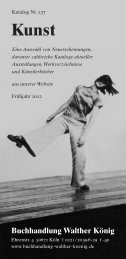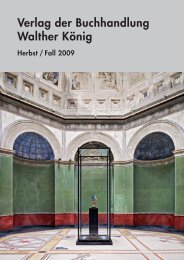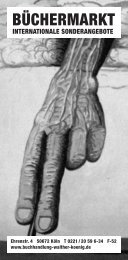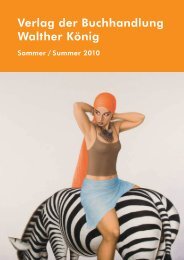Kunst - Buchhandlung Walther König
Kunst - Buchhandlung Walther König
Kunst - Buchhandlung Walther König
Erfolgreiche ePaper selbst erstellen
Machen Sie aus Ihren PDF Publikationen ein blätterbares Flipbook mit unserer einzigartigen Google optimierten e-Paper Software.
JOHNSON, RAY – ASHEVILLE, BLACK MOUNTAIN COLLEGE MUSEUM<br />
– From BMC to NYC. The Tutelary Years of Ray Johnson 1943–1967.<br />
Catalogue ed. by Sebastian Matthews. Asheville 2010. 4to. 48 S. mit 75<br />
meist farb. Abb., brosch.<br />
A seminal Pop Art figure, Ray Johnson has been called the most significant<br />
„unknown artist“ of the post-war period, a „collagist extraordinaire“ who influenced<br />
Pop artists such as Andy Warhol and Keith Haring, as well as a generation<br />
of contemporary artists. Since his death, however, Johnson has emerged<br />
not only as a key member of the 1960’s generation, but as one of the<br />
major artistic innovators of the second-half of the 20th century. The exhibition<br />
will explore the ways that many of Johnson’s early tutelary influences,<br />
both the people and the places, helped create his unique vision. Throughout<br />
his career, Johnson always found ways to engage those around him – mentors,<br />
friends and strangers alike – in a correspondence „dance“ of collage, letter<br />
writing and interactive performance art. Following in Marcel Duchamp’s<br />
footsteps, Johnson, as one art critic put it, „introduced life into art“<br />
1452256 19,95<br />
DONALD JUDD. By David Raskin. London 2010. 4to. 224 S. mit 140<br />
(60 farb.) Abb., Ppbd.<br />
This pioneering book, the first monograph devoted to Donald Judd, addresses<br />
the whole breadth of Judd’s practices. Drawing on documents found in<br />
nearly twenty archives, David Raskin explains why some of Judd’s works of<br />
art seem startlingly ephemeral while others remain insistently physical. In<br />
the process of answering this previously perplexing question, Raskin traces<br />
Judd’s principles from his beginnings as an art critic through his fabulous installations<br />
and designs in Marfa, Texas. He discusses Judd’s early important<br />
paintings and idiosyncratic red objects, as well as the three-dimensional<br />
works that are celebrated throughout the world. He also examines Judd’s<br />
commitment to empirical values and his political activism, and concludes by<br />
considering the importance of Judd’s example for recent art.<br />
1451294 39,95<br />
JUDD, DONALD – Stockebrand, Marianne.<br />
Chinati. Das Museum von Donald<br />
Judd. Beitr. von Rudi Fuchs, Richard<br />
Shiff & Nicholas Serota. Mit Texten<br />
von Donald Judd. Köln 2010. 4to. 328<br />
S. mit 240 (170 farb.) teils ganz- bzw.<br />
doppelseit. Abb., Bibliographie, Chronologie,<br />
Ln.<br />
Donald Judd zog 1973 von New York nach<br />
Marfa und hat hier bis zu seinem Tod 1994<br />
seine Vorstellungen von Architektur und<br />
<strong>Kunst</strong> realisiert. Er hat rund 30 Gebäude für<br />
die <strong>Kunst</strong> so umgebaut, wie es seinen Ansprüchen<br />
an eine richtige Form der Ausstellung entspricht. Hier hat er Werke<br />
für den Ort geschaffen und die Arbeiten seiner Freunde und geschätzter Kollegen<br />
installiert. Chinati zeigt diese Arbeiten auf einzigartige Weise in einer<br />
einzigartigen Landschaft: u. a. von John Chamberlain, Dan Flavin, Claes Oldenburg<br />
und Coosje van Bruggen, Ilya Kabakov, Richard Long, John Wesley,<br />
Roni Horn und David Rabinowitch. Marianne Stockebrand ist seit 1994 Direktorin<br />
der Chinati Foundation. Mit einem illustriertem Gesamtverzeichnis<br />
der Sammlung.<br />
1452637 49,95<br />
1451295 Englische Ausgabe 59,80
















